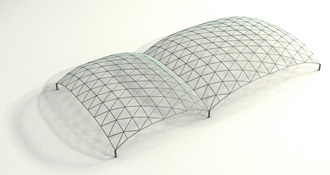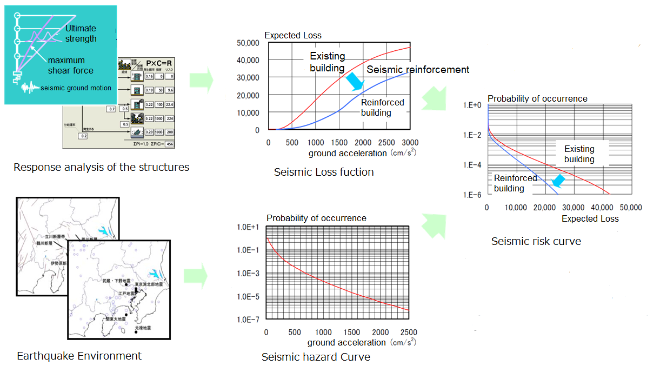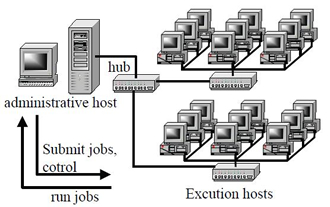
ここからコンテンツです。

Seeking Large Spatial Structures Resilient to Earthquakes
Study on the seismic design of shell and spatial structures By Shoji Nakazawa
Nakazawa, a professor at the Structural Mechanics Laboratory, and his team are proposing new analysis and design methods that take the buckling phenomenon into full consideration, and are conducting research on analytical methods and analysis software for seismic design in order to realize a safer and freer structure with respect to the “shell and spatial structures,” which are widely used as column-less large spaces such as school gymnasiums, sports arenas, and industrial structures such as tanks. We are also conducting research on an earthquake-resistance evaluation method based on earthquake risk analyses considering economic losses due to damage of nonstructural material, in addition to damage to major constructional material and the losses from the cessation of the building functionality. In addition, we are also working on parallel computing to implement them efficiently.

A “Shell and Spatial Structure” has a curved surface structure like a shell (dome, cylinder, etc.), and can cover a huge column-free space with thin and narrow parts (Fig. 1). Therefore, shell and spatial structures are widely used in industrial structures such as tanks, school gymnasiums, sports arenas, and others. This type of structure has a relatively high public interest and requires a high earthquake resistance. In particular, it is expected that school gymnasiums are to be used as evacuation facilities after earthquakes, and earthquake resistance performance evaluation for nonstructural materials, including ceiling materials, is gaining attention.
Our laboratory is conducting research on buckling design and earthquake-resistant designs for shell and spatial structures. Shell and spatial structures often use thin and narrow parts. Also, if compression is applied to the entire structure like a dome, a buckling phenomenon will occur, which means that an elongated part rapidly bends out in a lateral direction when compression is applied from both ends. Furthermore, when designing shell and spatial structures, it is necessary to take account of both the total buckling (shell buckling), in which the entire structure buckles, and individual buckling (Euler buckling of the columns), in which the parts buckle. We propose new analytical and design methods that take full account of these buckling phenomena.

For earthquake-resistant designs of shell and spatial structures, we are developing analysis software and conducting research on analysis methods to consider the questions, “How do buildings shake when an earthquake is occurring?”, and “At what intensity of shaking will buildings collapse?” We also are proposing a shell and spatial structure with base isolation devices and vibration dampers, in order to realize spatial structures that are safe, even when larger earthquakes occur.
In addition, at our laboratory, we are developing a seismic performance evaluation method based on earthquake risk analyses. In conventional earthquake-resistant designs, a design method that takes into consideration the yield strength and the deformability of the main structural members (columns, beams and earthquake-resistant walls) are adopted. Nowadays, the need for an evaluation of earthquake resistance performance that combines the damage of non-structural materials, including ceiling materials, and the function maintenance performance of buildings is increasing. The Earthquake Risk Analysis is a method of stochastically obtaining earthquake hazard (Seismic hazard curve) according to the construction position of the buildings and the amount of damage inflicted by the earthquake (Seismic loss function) from building strength and deformability. This method allows us to evaluate in consideration of economic losses due to the damage of nonstructural materials, in addition to damages to major constructional materials and losses due to the cessation of the building functionality.
By adopting this method: 1) it is possible to design buildings in such a way as to take account of the expenditure that the building will require during its service period (LCC, Life Cycle Cost. 2) It is possible to quantitatively measure the reduction in costs which results from installing base isolation devices and vibration dampers and to judge the effectiveness of seismic strengthening. 3) It can be used for analyzing earthquake function maintenance performances in school gymnasiums, factories, medical facilities, etc.

Furthermore, a faster computer is required to perform high-precision numerical analyses and earthquake risk analyses of large-scale structures such as shell and spatial structures. For example, in the seismic risk analysis, a large number of calculations (so-called Monte Carlo simulation) have to be performed in order to consider earthquake inputs and variations in the yield strength in structures. Therefore, we position parallel grid computing (Fig. 3), an HPC (High-Performance Computing) method, as the basic technology for our numerical analysis method and are also conducting research on simple HPC construction methods and how to utilize them in the field of construction civil engineering. Specifically, we are proposing optimization methods using a grid system and a genetic algorithm, and large-scale structural analysis methods using a grid parallel computing system.
地震に負けない大空間構造を求めて
シェル・空間構造の耐震設計に関する研究By 中澤 祥二
構造力学研究室の中澤教授の研究グループでは、タンクなどの産業構造物や学校体育館、スポーツアリーナなど柱のない大空間として幅広く利用されている「シェル・空間構造」について、安全かつより自由な構造物を実現するべく、座屈現象を十分に勘案した新しい解析・設計方法の提案や、耐震設計のための分析方法や解析ソフトについての研究を行っています。また、主構造材の損傷に加えて非構造材の損傷による経済的な損失や建物機能性が失われた時の損失を考慮した地震リスク解析に基づく耐震性の評価手法についての研究も行っています。さらには、これらを効率的に実施するための並列コンピューティングにも取り組んでいます。
「シェル・空間構造」は、貝殻のような曲面構造(ドーム、円筒など)であり、薄い部材や細い部材を用いて巨大な無柱空間を覆うことできます(Fig1)。そのため、シェル・空間構造はタンクなどの産業構造物や学校体育館、スポーツアリーナなどに幅広く利用されています。この種の構造物は比較的公共性が高く、高い耐震性が要求される構造物です。特に、学校体育館では、震災後に避難施設として利用することも想定されており、天井材などを含む非構造材の耐震性能評価にも注目が集まっています。
我々の研究室では、シェル・空間構造の座屈設計と耐震設計に関する研究を行っています。シェル・空間構造では、薄い部材や細い部材が利用されることが多くあります。また、ドームのように構造全体に圧縮力が作用している場合、座屈現象が発生します。座屈現象とは、細長い部材に両端からある圧縮力が作用したときに急激に横方向に孕みだす現象のことを言います。さらに、シェル・空間構造では、構造全体が座屈する全体座屈(シェル的座屈)や部材が座屈する個材座屈(柱のオイラー座屈)の両方を考慮して解析や設計をする必要があります。これらの座屈現象を十分に勘案した新しい解析方法や設計法を提案しています。
また、シェル・空間構造の耐震設計については、「地震が作用したときにどのように揺れるのか?」、「どの程度の地震動が作用すると壊れてしまうのか?」などを分析するための解析ソフトの開発、分析方法に関する研究を行っています。また、より大きな地震動が作用した場合でも安全な空間構造を実現するために、免震装置や制振ダンパーを導入したシェル・空間構造物の提案を行っています。
さらに本研究室では、地震リスク解析に基づく耐震性能評価手法の開発も行っています。従来の耐震設計では、主構造材(柱、梁や耐震壁)の耐力や変形能力を勘案した設計法が採用されています。現在では、天井材などを含む非構造材の損傷や建物の機能維持性能も併せた耐震性能評価の必要性が高まりつつあります。地震リスク解析は、建物の建設位置に応じた地震ハザード(地震危険度; Seismic hazard curve)と、建物耐力や変形性能から地震による被害額(地震ロス関数; Seismic loss function)を確率論的に求める手法です。この方法では、主構造材の損傷に加えて非構造材の損傷による経済的な損失や建物機能性が失われた時の損失を考慮した評価が可能となります。この手法を援用することにより、1) 建物が供用期間の間に受けるコスト (LCC、Life Cycle Cost)を勘案した設計が可能となります。また、2) 免震や制振部材を導入することによる損失コスト低減を定量的に評価し、耐震補強の有効性を判断することができます。そして、3) 学校体育館、工場、医療施設等の地震時機能維持性能の分析に利用することができます。
ところで、シェル・空間構造などの大規模構造物の高精度数値解析や地震リスク解析を行うためには、より高速のコンピュータが必要となります。例えば、地震リスク解析では地震入力や構造物の耐力のばらつきを考慮するために多数の演算(いわゆる、モンテカルロシミュレーション)を行う必要があります。そこで、本研究室では、HPC(ハイパフォーマンスコンピューティング)の1手法である並列グリッドコンピューティング(Fig3)を数値解析法の基盤技術と位置づけ、HPCの簡単な構築方法に関する研究や建築土木分野での活用方法に関する研究も行っています。具体的には、グリッドシステムと遺伝的アルゴリズムを用いた最適化手法の提案やグリッド並列計算システムを用いた大規模構造解析手法の提案などを行っています。
Researcher Profile

| Name | Shoji Nakazawa |
|---|---|
| Affiliation | Department of Architecture and Civil Engineering |
| Title | Professor / Presidential Advisor(Facility and Safety Affairs) |
| Fields of Research | Structural Engineering |
ここでコンテンツ終わりです。
